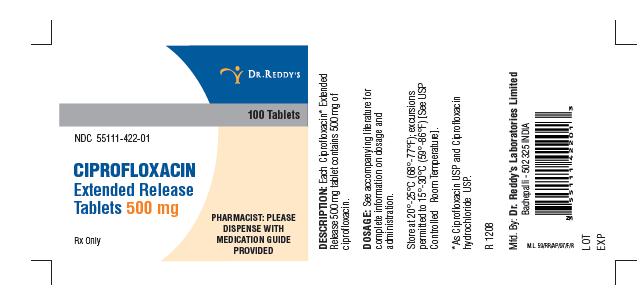
Ciprofloxacin Hydrochloride Tablet, Film Coated, Extended Release while Breastfeeding
What is Ciprofloxacin Hydrochloride Tablet, Film Coated, Extended Release used for?
Can I continue breastfeeding if I am using Ciprofloxacin Hydrochloride Tablet, Film Coated, Extended Release? How long does it stays in breast milk?

Nursing Mothers Ciprofloxacin is excreted in human milk. The amount of ciprofloxacin absorbed by the nursing infant is unknown. Because of the potential for serious adverse reactions in infants nursing from mothers taking ciprofloxacin, a decision should be made whether to discontinue nursing or to discontinue the drug, taking into account the importance of the drug to the mother.
Ciprofloxacin Hydrochloride Tablet, Film Coated, Extended Release Breastfeeding Analsys
Ciprofloxacin while Breastfeeding
SafeCAS Number: 85721-33-1
Quinolone-related medication has been used in neonates and infants without known side effects. It is excreted in tiny amounts into breast milk. Absorption through the child’s gut may be interfered by calcium in the milk. Should it be prescribed to a nursing mother Norfloxacine, Ofloxacine and Ciprofloxacine are to be chosen since they have shown a lowest excretion into the milk. One case of pseudomembranose colitis, possibly related to mother ingestion of Ciporfloxacine, in a premature infant has been described who previously was affected of NEC, Follow-up for diarrhea in the infant is warranted. Be aware of false negative bacterial cultures in the infant when the mother is on antibiotics. The American Academy of Pediatrics rates it compatible with breastfeeding.
Ciprofloxacin while Breastfeeding
SafeCAS Number: 85721-33-1

Quinolone-related medication has been used in neonates and infants without known side effects. It is excreted in tiny amounts into breast milk. Absorption through the child’s gut may be interfered by calcium in the milk. Should it be prescribed to a nursing mother Norfloxacine, Ofloxacine and Ciprofloxacine are to be chosen since they have shown a lowest excretion into the milk. One case of pseudomembranose colitis, possibly related to mother ingestion of Ciporfloxacine, in a premature infant has been described who previously was affected of NEC, Follow-up for diarrhea in the infant is warranted. Be aware of false negative bacterial cultures in the infant when the mother is on antibiotics. The American Academy of Pediatrics rates it compatible with breastfeeding.
Ciprofloxacin Hydrochloride Tablet, Film Coated, Extended Release Breastfeeding Analsys - 2
Ciprofloxacin while Breastfeeding
CAS Number: 85721-33-1
Amounts of ciprofloxacin in breastmilk are low. Fluoroquinolones such as ciprofloxacin have traditionally not been used in infants because of concern about adverse effects on the infants' developing joints. However, studies indicate little risk.[1] The calcium in milk might decrease absorption of the small amounts of fluoroquinolones in milk,[2] but, insufficient data exist to prove or disprove this assertion. Use of ciprofloxacin is acceptable in nursing mothers with monitoring of the infant for possible effects on the gastrointestinal flora, such as diarrhea or candidiasis (thrush, diaper rash). Avoiding breastfeeding for 3 to 4 hours after a dose should decrease the exposure of the infant to ciprofloxacin in breastmilk. Maternal use of an ear drop or eye drop that contains ciprofloxacin presents negligible risk for the nursing infant. To substantially diminish the amount of drug that reaches the breastmilk after using eye drops, place pressure over the tear duct by the corner of the eye for 1 minute or more, then remove the excess solution with an absorbent tissue.
Ciprofloxacin while Breastfeeding
CAS Number: 85721-33-1
Amounts of ciprofloxacin in breastmilk are low. Fluoroquinolones such as ciprofloxacin have traditionally not been used in infants because of concern about adverse effects on the infants' developing joints. However, studies indicate little risk.[1] The calcium in milk might decrease absorption of the small amounts of fluoroquinolones in milk,[2] but, insufficient data exist to prove or disprove this assertion. Use of ciprofloxacin is acceptable in nursing mothers with monitoring of the infant for possible effects on the gastrointestinal flora, such as diarrhea or candidiasis (thrush, diaper rash). Avoiding breastfeeding for 3 to 4 hours after a dose should decrease the exposure of the infant to ciprofloxacin in breastmilk. Maternal use of an ear drop or eye drop that contains ciprofloxacin presents negligible risk for the nursing infant. To substantially diminish the amount of drug that reaches the breastmilk after using eye drops, place pressure over the tear duct by the corner of the eye for 1 minute or more, then remove the excess solution with an absorbent tissue.
What should I do if I am breastfeeding mother and I am already exposed to Ciprofloxacin Hydrochloride Tablet, Film Coated, Extended Release?
It is always a good idea to keep your healthcare provider or doctor informed about your drug usage during pregnancy and breastfeeding but if you have not informed your doctor about Ciprofloxacin Hydrochloride Tablet, Film Coated, Extended Release and have used it then do not panic as Ciprofloxacin Hydrochloride Tablet, Film Coated, Extended Release is mostly safe in breastfeeding and should not cause any harm to your baby.
My doctor has prescribed me Ciprofloxacin Hydrochloride Tablet, Film Coated, Extended Release, what should I do?
Usage of Ciprofloxacin Hydrochloride Tablet, Film Coated, Extended Release is safe for nursing mothers and baby, No worries.
If I am using Ciprofloxacin Hydrochloride Tablet, Film Coated, Extended Release, will my baby need extra monitoring?
No
Who can I talk to if I have questions about usage of Ciprofloxacin Hydrochloride Tablet, Film Coated, Extended Release in breastfeeding?
US
National Womens Health and Breastfeeding Helpline: 800-994-9662 (TDD 888-220-5446) 9 a.m. and 6 p.m. ET, Monday through Friday
UK
National Breastfeeding Helpline: 0300-100-0212 9.30am to 9.30pm, daily
Association of Breastfeeding Mothers: 0300-330-5453
La Leche League: 0345-120-2918
The Breastfeeding Network supporter line in Bengali and Sylheti: 0300-456-2421
National Childbirth Trust (NCT): 0300-330-0700
Australia
National Breastfeeding Helpline: 1800-686-268 24 hours a day, 7 days a week
Canada
Telehealth Ontario for breastfeeding: 1-866-797-0000 24 hours a day, 7 days a week
